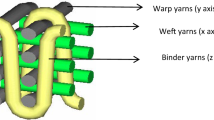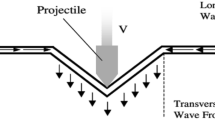Abstract
For some severe applications, pieces are made in composite materials with woven fabrics reinforcements: interlock. High yarn density and specific weaving pattern can slow the production speed because of yarn damages. The purpose of this study is to identify conditions causing warp yarn damages during dense weaving in terms of weaving sequence, interlacing and yarn structure and morphology. Two approaches are followed in-situ on the weaving machine and in-lab on a tribometer designed for this study. An instrumented 3D interlock machine is used in order to measure yarn tension and contact force during weaving. A specific sequence with different kinds of yarn intercrossings is applied and the more aggressive cases in terms of yarn tension and contact force are identified. From the data acquired on the weaving machine, a specific tribometer reproducing the intercrossing between two yarns with different yarn tension and contact force has been developed. The results obtained from weaving and friction tests show the source of aggressive conditions: i) the Jacquard mechanics: higher tension and contact force are obtained while yarn has a raising movement in comparison to a lowering movement, ii) the intercrossing sequence: a single yarn in movement with its neighbours having an opposite movement, iii) yarn structure and morphology: a coarse yarn and/or with twist, because it is bulky however it also have a better cohesion, therefore a compromise has to be found, iv) normal load increases yarn damage, and decreases the coefficient of friction, however the effect of yarn tension is not determined.















Similar content being viewed by others
References
Mouritz, A.P., Bannister, M.K., Falzon, P.J., Leong, K.H.: Review of applications for advanced three-dimensional fibre textile composites. Compos. A Appl. Sci. Manuf. 30, 1445–1461 (1999). https://doi.org/10.1016/S1359-835X(99)00034-2
Morton, W.E., Hearle, J.W.S., Morton, W.E., Hearle, J.W.S.: Physical properties of textile fibres. pp. 274–455. Woodhead publishing in textiles (2008)
Hu, J.: 3-D Fibrous Assemblies - Properties, Applications and Modelling of Three-Dimensional Textile Structures. pp. 127–129. Woodhead Publishing (2008)
Boisse, P.: Composite Reinforcements for Optimum Performance. pp. 89–115. Woodhead Publishing (2011)
Mathes, V.: The composites industry: plenty of opportunities in heterogeneous market. Reinf. Plast. 62, 44–51 (2018). https://doi.org/10.1016/j.repl.2017.05.002
Coupé, D.: 3D textile structures for aeronautic applications. Proceedings of the 8th World conference on 3D fabrics and their applications, Roubaix, France (2016)
Boussu, F., Provost, B., Lefebvre, M., Coutellier, D.: New Textile Composite Solutions for Armouring of Vehicles. Adv. Mater. Sci. Eng. 2019, e7938720 (2019). https://doi.org/10.1155/2019/7938720
Bessette, C., Decrette, M., Tourlonias, M., Osselin, J.-F., Charleux, F., Coupé, D., Bueno, M.-A., In-situ measurement of tension and contact forces for weaving process monitoring: Application to 3D interlock. Composites Part A: Appl. Sci. Manuf. 126, (2019). https://doi.org/10.1016/j.compositesa.2019.105604
Leca, A.: Contribution à l’étude de la santé-matière de préformes carbone, PhD Thesis. Université du Havre, (2015)
Florimond, C., Ramezani-Dana, H., Vidal-Sallé, E.: Identification of Fibre Degradation due to Friction during the Weaving Process, KEM. 416, 554–557 (2013) https://doi.org/10.4028/www.scientific.net/KEM.554-557.416
Decrette, M., Osselin, J.-F., Drean, J.-Y.: Motorized Jacquard technology for multilayer weaving damages study and reduction: Shed profile and close shed profile. J. Eng. Fibers Fabr. 14, 11 (2019). https://doi.org/10.1177/1558925019833025
Decrette, M., Mourad, S., Osselin, J.-F., Drean, J.-Y.: Jacquard UNIVAL 100 parameters study for high-density weaving optimization. J. Ind. Text. 45, 1603–1618 (2016). https://doi.org/10.1177/1528083714567241
McHugh, C.: The use of Recent Developments in conventional Weaving & Shedding technology to create 3D one piece woven Carbon Preforms, SAMPE Journal 18, (2009)
Archer, E., Buchanan, S., McIlhagger, A.T., Quinn, J.P.: The effect of 3D weaving and consolidation on carbon fiber tows, fabrics, and composites, J. Reinf. Plast. Compos. (2010). https://doi.org/10.1177/0731684410371405
Abtew, M.A., Boussu, F., Bruniaux, P., Loghin, C., Cristian, I., Chen, Y., Wang, L.: Yarn degradation during weaving process and its effect on the mechanical behaviours of 3D warp interlock p-aramid fabric for industrial applications. J. Ind. Text. 24, (2020). https://doi.org/10.1177/1528083720937288
Lee, B., Leong, K.H., Herszberg, I.: Effect of Weaving on the Tensile Properties of Carbon Fibre Tows and Woven Composites. J. Reinf. Plast. Compos. 20, 652–670 (2001). https://doi.org/10.1177/073168401772679011
Lee, L., Rudov-Clark, S., Mouritz, A.P., Bannister, M.K., Herszberg, I.: Effect of weaving damage on the tensile properties of three-dimensional woven composites. Compos. Struct. 57, 405–413 (2002). https://doi.org/10.1016/S0263-8223(02)00108-3
Wendling-Hivet, A., Ramón Ferré, M., Allaoui, S., Nunez, R., Loison, S., Hivet, G.: Study of the cohesion of carbon fiber yarns: in-plane shear behavior. Int J Mater Form. 10, 671–683 (2016). https://doi.org/10.1007/s12289-016-1310-y
Sharp, K.W., Bogdanovich, A.E.: Fiber damage imparted by 3D orthogonal weaving of pitch carbon and ceramic yarns, Proceedings of ICCM17, Edinburgh,10 (2009)
Wu, N., Xie, X., Yang, J., Feng, Y., Jiao, Y., Chen, L., Xu, J., Jian, X.: Effect of normal load on the frictional and wear behaviour of carbon fiber in tow-on-tool contact during three-dimensional weaving process. J. Ind. Text.. 21, (2020). https://doi.org/10.1177/1528083720944615
Weise, D., Vorhof, M., Brünler, R., Sennewald, C., Hoffmann, G., Cherif, C.: Reduction of weaving process-induced warp yarn damage and crimp of leno scrims based on coarse high-performance fibers: Textile Research Journal. (2018). https://doi.org/10.1177/0040517518809049
Kashif, M., Hamdani, S.T.A., Nawab, Y., Asghar, M.A., Umair, M., Shaker, K.: Optimization of 3D woven preform for improved mechanical performance. J. Ind. Text. 48, 1206–1227 (2019). https://doi.org/10.1177/1528083718760802
Hu, X., Ying, Z., Cheng, X., Wu, Z.: Effect of Z-binder tension and internal micro-structure on damage behavior of 3D orthogonal woven composite. J. Ind. Text. 49, 551–571 (2019). https://doi.org/10.1177/1528083718791328
Kumar, S., Balachander, S.: Studying the effect of reinforcement parameters on the mechanical properties of natural fibre-woven composites by Taguchi method. J. Ind. Text. 16, (2019). https://doi.org/10.1177/1528083718823292
Guo, Q.: Effect of bias yarn on tensile fracture mechanism of multiaxial 3D angle-interlock woven composites. Thin-Walled Structures. 15, (2020). https://doi.org/10.1016/j.tws.2020.107269
Fan, W.: Fatigue behavior of the 3D orthogonal carbon/glass fibers hybrid composite under three-point bending load. Materials and Design. 9, (2019)
Yang X., Fan W., Ge S., Gao X., Wang S., Zhang Y., Foong S. Y., Liew R. K., Lam S. S. et Xia C., Advanced textile technology for fabrication of ramie fiber PLA composites with enhanced mechanical properties - Industrial Crops and Products. vol.162, 113312 (2021). https://doi.org/10.1016/j.indcrop.2021.113312
AFNOR NF EN ISO 2078 1995/01 Verre textile, Fils, Désignation, (1995)
Bueno, M.-A., Durand, B., Renner, M.: Optical characterization of the state of fabric surfaces. OE. 39, 1697–1703 (2000). https://doi.org/10.1117/1.602547
Tourlonias, M., Bueno, M.-A.: Experimental simulation of friction and wear of carbon yarns during the weaving process. Compos. A Appl. Sci. Manuf. 80, 228–236 (2016). https://doi.org/10.1016/j.compositesa.2015.07.024
Tourlonias, M., Bueno, M.-A., Poquillon, D.: Friction of carbon tows and fine single fibres. Compos. A Appl. Sci. Manuf. 98, 116–123 (2017). https://doi.org/10.1016/j.compositesa.2017.03.017
Bowden, F.P., Young, J.E.: Friction of diamond, graphite, and carbon and the influence of surface films. Proc. R. Soc. Lond. A. 208, 444–455 (1951). https://doi.org/10.1098/rspa.1951.0173
Howell HG, Mieszkis KW, Tabor D. Friction in Textiles, Butterworths Scientific Publications (1959).
Gupta BS. Friction in Textile Materials. CRC Press, The Textile Institute and Woodhead Publishing Limited (2008).
Aliouche, D., Viallier, P., Mechanical and Tactile Compression of Fabrics: Influence on Handle. Text. Res. J. 70, 939–944 (2000). https://doi.org/10.1177/004051750007001101
Acknowledgements
The authors are deeply grateful to Sascha Krügl, engineer at the University of Haute Alsace, for his help for the design of the tribometer and to M2A (Mulhouse Alsace Agglomération) for its support.
Author information
Authors and Affiliations
Corresponding author
Ethics declarations
Conflict of interest
The authors have no conflict of interest.
Additional information
Publisher's Note
Springer Nature remains neutral with regard to jurisdictional claims in published maps and institutional affiliations.
Rights and permissions
About this article
Cite this article
Walther, J., Bessette, C., Decrette, M. et al. Yarn Damage Conditions Due to Interactions During Interlock Weaving Process: In-situ and In-lab Experiments. Appl Compos Mater 29, 245–262 (2022). https://doi.org/10.1007/s10443-021-09950-7
Received:
Accepted:
Published:
Issue Date:
DOI: https://doi.org/10.1007/s10443-021-09950-7




